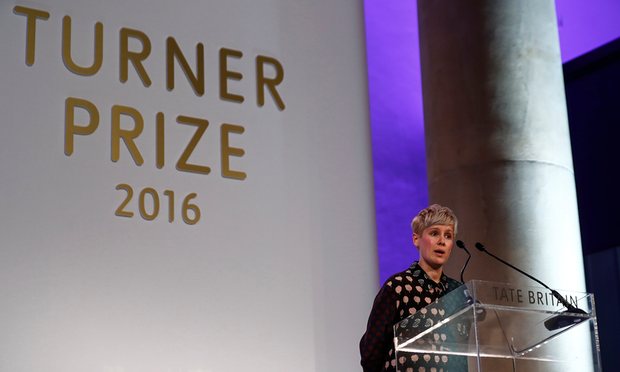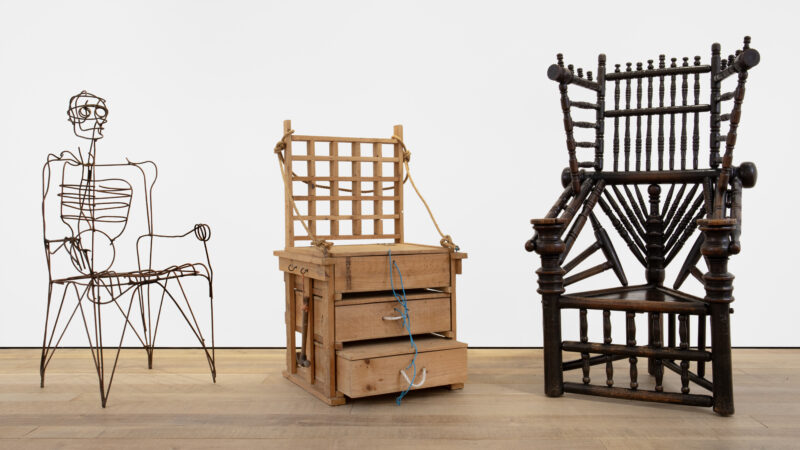
Helen Marten makes a speech after being announced as the winner of the Turner prize at the Tate Gallery in London. Photograph: Eddie Keogh/Reuters
Helen Marten has sealed her position as one of the UK’s most exciting young artists after being named the winner of the 2016 Turner prize, her second big award in the space of a month.
The 31-year-old artist, who was born in Macclesfield, was presented with her £25,000 prize by the writer Ben Okri at a ceremony at London’s Tate Britain gallery.
It comes only weeks after she won the £30,000 Hepworth Prize for Sculpture. On that occasion Marten announced from the stage that she would be sharing the winnings with her fellow artists and she later confirmed she would be doing the same thing with the Turner Prize. “I don’t feel I need to politicise that gesture,” she said. “I can do it quietly.”
She won for work which baffles gallery goers as much as it grips and delights them. Marten creates complex sculptures from a bewildering array of materials and invites people to investigate them as they might an archaeological dig.

Marten said she was feeling “numb” after being named winner, but “deeply honoured”.
Part of her did not want to win, she admitted, and she did not enjoy the media spectacle and publicity – “it can only be unhealthy and difficult for the people involved”. But the amount of people seeing her work had proved interesting and educational.
It may even change the vocabulary she uses in her work, Marten said. “It makes you realise that the art world as a whole is operating in a very hermetic bubble of sign language that is not necessarily generous to a wider public audience which is not initiated in that kind of language or visual information.
“Putting something here and seeing what the public perception of it is is very humbling and educational, it makes you think maybe my work is not universal, maybe the themes I’m employing are not immediately understandable.”
The chair of judges, Tate Britain director Alex Farquharson, said Marten, who is based in London, was making work which had real longevity and was using objects, forms and images in a similar way to a poet using language.
“The judges were impressed by the complexity of the work, its amazing formal qualities, its disparate materials and techniques and also how it relates to the world … how it often suggests meaning, but those meanings are all in flux somehow. One image, one form becomes another.”

Marten’s work resists being pinned down and that is a good thing, said Farquharson. “It is like experience of the world in real time, it reflects a complex world, not one that can be boiled down to singular statements or buzzwords.
“Her work reflects the condition of the world and particularly the condition of the visual world, one that is always accelerating, especially under the influence of the internet.”
Past Turner prize winners have often been simple to explain: Martin Creed’s light going on and off, Mark Wallinger’s recreation of a Parliament Square protest, Chris Ofili’s paintings made from elephant dung.
This year it is trickier, Farquharson condeded. “It is a long long way away from a one-liner artwork, if it was a line it would be a sentence… a Proustian sentence.”
For her Turner prize exhibition Marten used materials and objects that include cotton buds, bicycle chains, shells, marbles, snooker chalk, fish skins and eggs, among much else.
Marten had been many people’s favourite to win the prize and it caps an extraordinary year following a major show at London’s Serpentine Gallery and winning the inaugural Hepworth prize for sculpture last month.

On winning the Hepworth prize she told the Guardian: “I feel frankly a little embarrassed about it all… I hate things like this.” Marten followed the example of the last winner of the Artes Mundi prize, the Chicago artist Theaster Gates, by announcing she would share the money with her fellow shortlisted artists.
Given the year it has been politically and culturally, some observers had been willing judges to choose Anthea Hamilton as winner. Her most eye-catching work had been a giant naked bottom – surely a fitting artistic goodbye to 2016.
But it was not to be. Also losing out was Josephine Pryde, who displayed photographic portraits of hands and Ikea kitchen counter tops which had been left out in the sun. In the middle of the gallery was a model train which people at other shows were able to ride. For London it was decommissioned.
The fourth shortlisted artist was Michael Dean, whose most striking installation was a giant heap or island of penny pieces which explored how difficult it is for families to get by in Britain today. They amounted to £20,436, which is what the government believes is the minimum that two adults and two children need to survive for a year in the UK. Dean then removed one penny meaning his characters were below the poverty line.
The Turner prize, given to an artist under 50, is judged on exhibitions which have been presented in the preceding year rather than the work they make for the Turner Prize show. In Marten’s case it was for her Lunar Nibs project at this year’s Venice Biennale and her solo show Eucalyptus Let Us In at Greene Naftali in New York.
The prize always sparks debate and division. This year’s list has been criticised as not political enough or too political. Wonderfully baffling or maddeningly meaningless.

For the Stuckists, an anti conceptual art group of artists who have been protesting against the prize since 2000, it was this year unforgivably dull.
Charles Thomson, co-founder of the group, said: “It is appalling that innocent victims expecting to see challenging art should end up bored to death. I have lost several friends in the last few weeks.
“There needs to be immediate action. The Turner prize should be shut down before more people end up meeting their demise from sheer boredom.”
Tate, which has been organising the prize since 1984, will not mind negative comments – far from it, generating debate about contemporary art is the key to its importance.
This year prize organisers have gone even further in an attempt to spark conversations. There are sofas outside the show for people to chat and taking photographs and video of the works has been allowed where it was previously banned.
The prize was back in London after last year’s visit to Glasgow where a collective of young architects, Assemble, won. Next year it will be at Hull’s Ferens art gallery as part of the UK city of culture celebrations.
This year’s judging panel, chaired by Farquharson, took two and half hours to agree a winner. They were Michelle Cotton, director of Bonner Kunstverein, Bonn; curator Tamsin Dillon; Beatrix Ruf, director of the Stedelijk museum, Amsterdam; and Simon Wallis, director of the Hepworth Wakefield.
guardian.co.uk © Guardian News & Media Limited 2010
Published via the Guardian News Feed plugin for WordPress.









